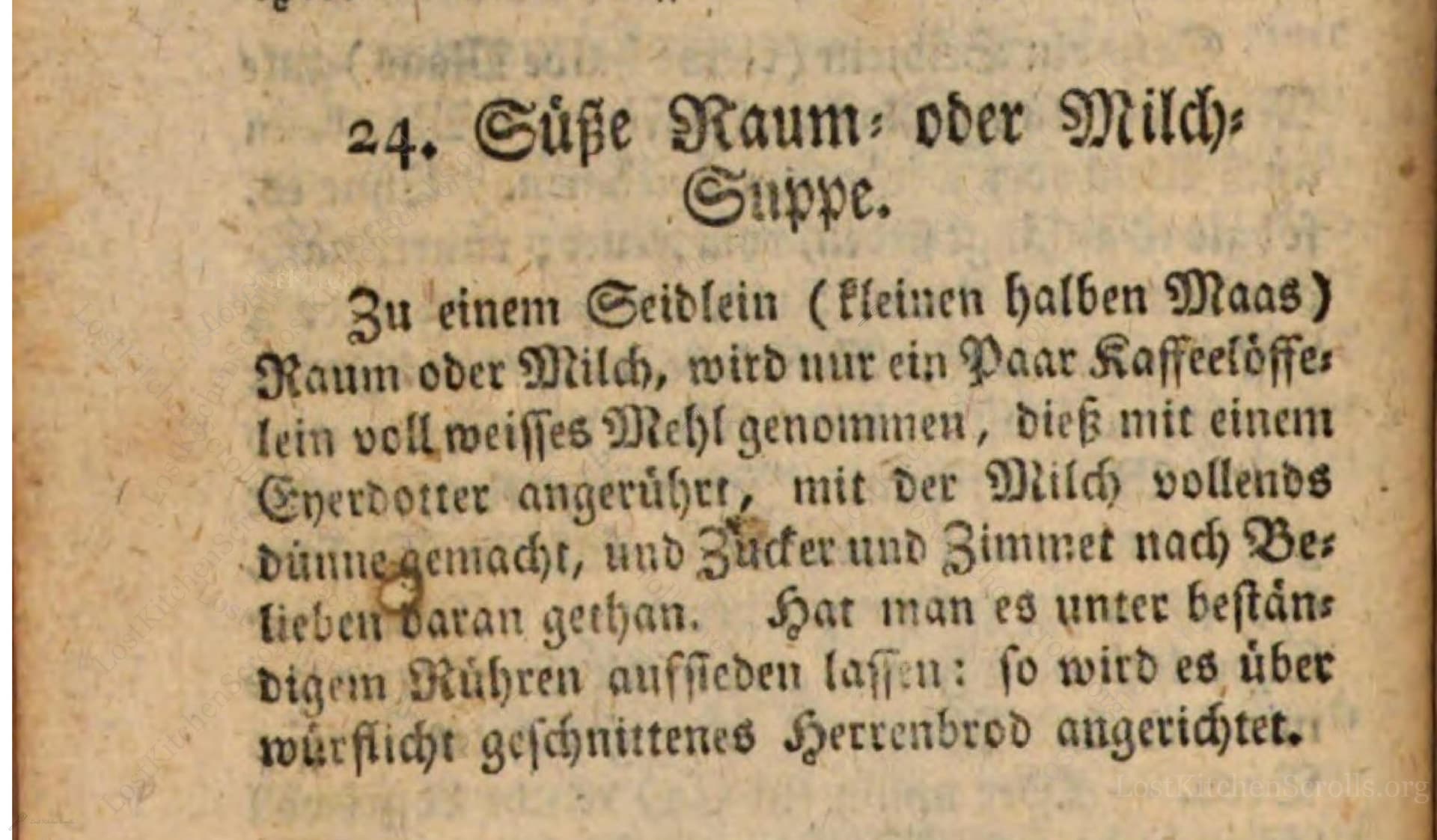Süsse Raum- Oder Milch-Suppe
"Sweet Cream Or Milk Soup"
From the treasured pages of Augsburgisches Kochbuch
Written by Sophie Juliane Weiler

Süsse Raum- Oder Milch-Suppe
"Zu einem Seidlein (kleinen halben Maas) Raum oder Milch, wird nur ein Paar Kaffeelöffellein voll weisses Mehl genommen, dieß mit einem Eyerdotter angerührt, mit der Milch vollends dünne gemacht, und Zucker und Zimmet nach Belieben daran gethan. Hat man es unter beständigem Rühren aufsieden lassen: so wird es über würflicht geschnittenes Herrenbrod angerichtet."
English Translation
"For a small half measure of cream or milk, take only a couple of small coffee spoons of white flour, mix this with an egg yolk, thin it out completely with the milk, and add sugar and cinnamon to taste. Once you have brought it to a boil while stirring constantly, serve it over diced rye bread."
Note on the Original Text
The original recipe is concise, with minimal instructions and measured largely by experience or familiar household vessels (like 'Ein Seidlein' for liquid). Spelling conventions reflect late 18th-century German, with variants like 'Eyerdotter' for 'Eigelb' (egg yolk) and 'Zimmet' for 'Zimt' (cinnamon), and long sentences that move fluidly from preparation to serving. Care is required with 18th-century recipes to interpret amounts and processes for modern kitchens—here, minimal quantities and constant stirring are key to successful thickening and avoiding lumps or curdling.

Title
Augsburgisches Kochbuch (1788)
You can also click the book image above to peruse the original tome
Writer
Sophie Juliane Weiler
Era
1788
Publisher
In der Joseph-Wolffischen Buchhandlung
Background
A delightful journey through 18th-century German cuisine, the Augsburgisches Kochbuch serves up a generous helping of traditional recipes and household wisdom, inviting readers to savor the flavors and customs of its era.
Kindly made available by
Bayerische Staatsbibliothek
This recipe comes from the 'Augsburgisches Kochbuch,' published in 1788 by Sophie Juliane Weiler, a prominent figure in southern German cookery of the late Enlightenment. At that time, sweet, nourishing milk-based soups played a central role in breakfast and lighter meals, especially in well-to-do towns like Augsburg. These dishes combined accessible dairy and bread with more expensive spices and sugar, reflecting the period's fascination with sweet and savory contrasts and its gradual embrace of luxury ingredients in home kitchens. The recipe offers a glimpse into urban domestic life in the late 18th century, bridging practical frugality (using leftover bread) with a growing appreciation for refined, sweet flavors.

Historically, this soup would have been prepared using a clay or copper pot set over an open hearth or wood stove, with a wooden spoon or whisk for stirring. Measuring was often by eye or using household objects, such as a Seidlein (a small jug; here interpreted as about 250 ml). The bread would be cut with a sturdy kitchen knife and presented in a simple ceramic or wooden bowl. Modern cooks will find a heavy-bottomed saucepan and a balloon whisk ideal. A sharp bread knife and heatproof bowls complete the setup.
Prep Time
5 mins
Cook Time
10 mins
Servings
2
We've done our best to adapt this historical recipe for modern kitchens, but some details may still need refinement. We warmly welcome feedback from fellow cooks and culinary historians — your insights support the entire community!
Ingredients
- 1 cup cream or whole milk
- 1/4 oz (2 teaspoons) plain white flour
- 1 egg yolk
- Sugar (to taste, approx. 1-2 tablespoons, or 1/2 - 1 oz)
- Ground cinnamon (to taste, around 1/4 teaspoon, or 1/32 oz)
- 2 oz sturdy white or rye bread, cut into small cubes (substitute: pumpernickel or other firm bread)
Instructions
- To prepare this sweet cream or milk soup in a modern kitchen, take 1 cup of single cream or whole milk.
- Blend together 2 teaspoons (about 1/4 oz) of plain white flour with 1 egg yolk until smooth.
- Gradually whisk in the milk to thin the mixture.
- Add sugar and cinnamon to taste.
- In a saucepan, bring the mixture to a gentle boil over medium heat, stirring constantly to prevent curdling or burning, and let it simmer until slightly thickened.
- Meanwhile, cut a sturdy white bread (such as artisan sourdough or rye, ideally a day old) into small cubes.
- Once the soup has thickened, pour it hot over the prepared bread cubes in serving bowls.
- Enjoy immediately for the best texture.
Estimated Calories
250 per serving
Cooking Estimates
It takes about 5 minutes to prepare the ingredients and 10 minutes to cook the soup. Each serving contains around 250 calories, and this recipe makes 2 servings.
As noted above, we have made our best effort to translate and adapt this historical recipe for modern kitchens, taking into account ingredients nowadays, cooking techniques, measurements, and so on. However, historical recipes often contain assumptions that require interpretation.
We'd love for anyone to help improve these adaptations. Community contributions are highly welcome. If you have suggestions, corrections, or cooking tips based on your experience with this recipe, please share them below.
Join the Discussion
Rate This Recipe

Den Bockfisch In Einer Fleisch Suppen Zu Kochen
This recipe hails from a German manuscript cookbook compiled in 1696, a time whe...

Die Grieß Nudlen Zumachen
This recipe comes from a rather mysterious manuscript cookbook, penned anonymous...

Ein Boudain
This recipe comes from an anonymous German-language manuscript cookbook from 169...

Ein Gesaltzen Citroni
This recipe, dating from 1696, comes from an extensive anonymous German cookbook...
Browse our complete collection of time-honored recipes



